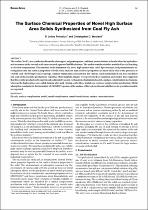 ResearchSpace
ResearchSpace
Surface chemical properties of novel high surface area solids synthesized from coal fly ash
JavaScript is disabled for your browser. Some features of this site may not work without it.
- ResearchSpace
- →
- Research Publications/Outputs
- →
- Journal Articles
- →
- View Item
| dc.contributor.author |
Pretorius, PJ

|
en_US |
| dc.contributor.author |
Woolard, CD

|
en_US |
| dc.date.accessioned | 2007-03-26T13:32:01Z | en_US |
| dc.date.accessioned | 2007-06-07T10:04:36Z | |
| dc.date.available | 2007-03-26T13:32:01Z | en_US |
| dc.date.available | 2007-06-07T10:04:36Z | |
| dc.date.copyright | en_US | |
| dc.date.issued | 2003-07-23 | en_US |
| dc.identifier.citation | Pretorius, PJ and Woolard, CD. 2003. Surface chemical properties of novel high surface area solids synthesized from coal fly ash. South African Journal of Chemistry, vol. 56, pp 34-39 | en_US |
| dc.identifier.issn | 0379-4350 | en_US |
| dc.identifier.uri | http://hdl.handle.net/10204/2071 | en_US |
| dc.identifier.uri | http://hdl.handle.net/10204/2071 | |
| dc.description.abstract | The zeolite, Na-P1, was synthesized from fly ash samples originating from coal-fired power stations in South Africa by hydrothermal treatment of the raw ash with concentrated aqueous NaOH solutions. The zeolite was then further modified by acid leaching at elevated temperatures. This resulted in the formation of a novel high surface-area solid. Spectroscopic and potentiometric investigations into the surface properties of both solids indicate that acid-base properties are most likely due to the presence of =AlOH- and =SiOH-type surface groups. Surface protonation constants for the various solids (unmodified ash, base-modified ash, and acid-etched zeolitic product) are reported. Metal sorption studies were performed for cadmium and copper. It is suggested that the zeolitic product sorbs copper and cadmium by an ion exchange mechanism instead of a surface complexation mechanism, whereas the high surface-area solid, formed after acid etching, sorbs these metals via a surface complexation mechanism. Metal adsorption constants for the formation of =XOMOH species on the surface of the last mentioned solid for use in speciation models are reported. | en_US |
| dc.format.extent | 846536 bytes | en_US |
| dc.format.mimetype | application/pdf | en_US |
| dc.language.iso | en | en_US |
| dc.publisher | Bureau Scientific Publications | en_US |
| dc.rights | Copyright: 2003 Bureau Scientific Publications | en_US |
| dc.source | en_US | |
| dc.subject | Fly ash | en_US |
| dc.subject | Surface complexation model | en_US |
| dc.subject | Metal complexation | en_US |
| dc.subject | Waste beneficiation | en_US |
| dc.subject | Surface characterization | en_US |
| dc.subject | Multidisciplinary chemistry | en_US |
| dc.title | Surface chemical properties of novel high surface area solids synthesized from coal fly ash | en_US |
| dc.type | Article | en_US |
| dc.identifier.apacitation | Pretorius, P., & Woolard, C. (2003). Surface chemical properties of novel high surface area solids synthesized from coal fly ash. http://hdl.handle.net/10204/2071 | en_ZA |
| dc.identifier.chicagocitation | Pretorius, PJ, and CD Woolard "Surface chemical properties of novel high surface area solids synthesized from coal fly ash." (2003) http://hdl.handle.net/10204/2071 | en_ZA |
| dc.identifier.vancouvercitation | Pretorius P, Woolard C. Surface chemical properties of novel high surface area solids synthesized from coal fly ash. 2003; http://hdl.handle.net/10204/2071. | en_ZA |
| dc.identifier.ris | TY - Article AU - Pretorius, PJ AU - Woolard, CD AB - The zeolite, Na-P1, was synthesized from fly ash samples originating from coal-fired power stations in South Africa by hydrothermal treatment of the raw ash with concentrated aqueous NaOH solutions. The zeolite was then further modified by acid leaching at elevated temperatures. This resulted in the formation of a novel high surface-area solid. Spectroscopic and potentiometric investigations into the surface properties of both solids indicate that acid-base properties are most likely due to the presence of =AlOH- and =SiOH-type surface groups. Surface protonation constants for the various solids (unmodified ash, base-modified ash, and acid-etched zeolitic product) are reported. Metal sorption studies were performed for cadmium and copper. It is suggested that the zeolitic product sorbs copper and cadmium by an ion exchange mechanism instead of a surface complexation mechanism, whereas the high surface-area solid, formed after acid etching, sorbs these metals via a surface complexation mechanism. Metal adsorption constants for the formation of =XOMOH species on the surface of the last mentioned solid for use in speciation models are reported. DA - 2003-07-23 DB - ResearchSpace DP - CSIR KW - Fly ash KW - Surface complexation model KW - Metal complexation KW - Waste beneficiation KW - Surface characterization KW - Multidisciplinary chemistry LK - https://researchspace.csir.co.za PY - 2003 SM - 0379-4350 T1 - Surface chemical properties of novel high surface area solids synthesized from coal fly ash TI - Surface chemical properties of novel high surface area solids synthesized from coal fly ash UR - http://hdl.handle.net/10204/2071 ER - | en_ZA |





